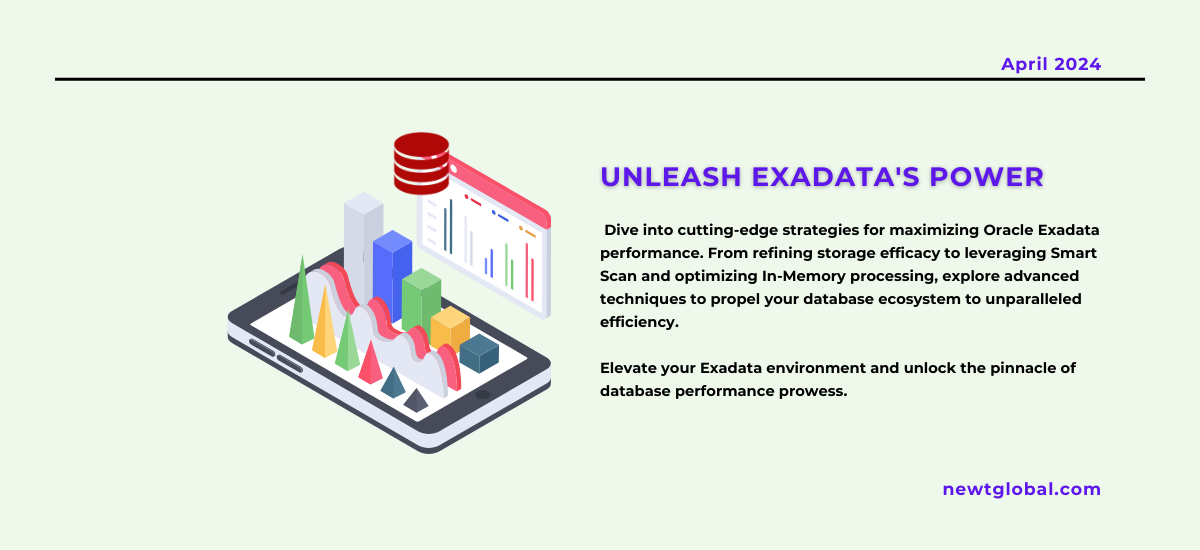
In today’s fast-paced world of databases, where every millisecond counts, speed is king. Oracle Exadata is a powerful system that combines top-notch hardware with smart software to create a super-fast and efficient platform for your databases. This guide will show you how to unlock the full potential of Exadata and make your databases run at their absolute best.
Understanding Exadata
Before we dive into how to make Exadata even better, let’s break down what it actually is. Exadata is more than just a regular database appliance. It’s a powerhouse built for speed and growth. It has a special design that combines servers, storage, and networking in a way that gets rid of bottlenecks and lets data flow through much faster. This makes Exadata the perfect choice for businesses that need a lot of power for their databases.
Fine-Tuning Storage
Exadata has a built-in storage system that’s a big part of why it’s so fast. It uses things like Smart Flash Cache and Hybrid Columnar Compression to speed up how data is accessed and to take up less space. To get the most out of your storage, you can set it up in a way that works best for what you’re using your database for. Exadata can store data in different tiers, so you can keep the data you use all the time in the super-fast storage and put less important data in a cheaper tier.
Smart Scan Makes Queries Fly
Smart Scan is like Exadata’s secret weapon for making queries super fast. It works by moving some of the work of processing queries over to the storage servers. This way, there’s less data that needs to be moved around, which cuts down on wait time and makes everything run smoother. To use Smart Scan effectively, you’ll want to make sure your SQL queries are written well and that you have good indexes in place. You should also try to avoid getting more data than you need by using features like predicate pushdown and Exadata-specific features like storage indexes.
Supercharge Analysis with In-Memory Processing
Exadata’s In-Memory features let you analyze data and generate reports lightning fast by keeping frequently used data in memory, ready to be accessed instantly. To get the most out of In-Memory processing, figure out which datasets are most important and put those in memory first. Exadata also has Automatic Data Optimization (ADO) that can automatically move data between disk and memory based on how often it’s used and your business needs. By using In-Memory processing wisely, you can get insights in real time and make your analysis tasks much faster.
Resource Manager Keeps Things Fair
When you have a lot of different things going on in your database environment, they can start to compete for resources, which can slow things down. Exadata’s Resource Manager helps you avoid this by letting you control how resources are used and who gets priority. You can create plans that give different workloads the amount of CPU, memory, and storage they need based on their importance and how important it is for them to meet certain service levels (SLAs). By setting resource limits and priorities, the Resource Manager makes sure everyone gets a fair share of the resources and that no single runaway query or workload can slow everything else down.
Optimizing Network Configuration
Exadata uses a high-speed InfiniBand network to move data quickly between servers and storage. To get the best performance out of your network, you’ll want to fine-tune settings like MTU size, jumbo frames, and InfiniBand bonding. Exadata also has network diagnostic tools that you can use to see how much bandwidth is being used, find bottlenecks, and adjust network settings to get the best speed and reduce wait times.
Always Be Monitoring and Improving
Making your database run as fast as possible is an ongoing process. Exadata has a lot of tools built in to help you monitor how things are going and find potential problems before they slow you down. Tools like ExaWatcher and Enterprise Manager can help you keep an eye on your system health, see if anything is performing poorly, and take steps to fix it before it becomes a big issue. You should also regularly check system metrics, review how your queries are being executed, and adjust database settings as needed to keep up with how your workload and business needs change over time.
Get the Most Out of Your Exadata Investment
In today’s competitive business world, making sure your databases run as fast as possible is essential for staying ahead of the game. Oracle Exadata, with its powerful features and advanced capabilities, can help your organization reach new heights of performance and scalability. By following the strategies in this guide and making continuous improvement a priority, you can unlock the full potential of Exadata and take your database environment to a whole new level of efficiency and responsiveness.
If you’re looking at the bigger picture and considering a shift to a cloud-native database solution that’s fast, efficient, and cost-effective, we’ve got just the thing for you. Newt Global DMAP is a world-class product enabling mass migration of Oracle Db to cloud-native PostgreSQL faster, better, and cheaper. It’s designed to streamline the transition process, making it smoother and more straightforward for your organization to move to a modern database system in the cloud.
Interested in learning more about how Newt Global DMAP can transform your database migration journey? Visit us at newtglobal.com for more information on our services and solutions. And if you have any questions or need to get in touch with our team, please don’t hesitate to reach out at marketing@newtglobalcorp.com. Let us help you elevate your database infrastructure to meet the demands of today’s digital world.
